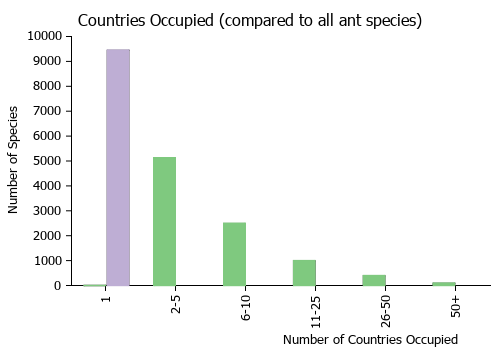Iridomyrmex macrops
| Iridomyrmex macrops | |
|---|---|

| |
| Scientific classification | |
| Kingdom: | Animalia |
| Phylum: | Arthropoda |
| Class: | Insecta |
| Order: | Hymenoptera |
| Family: | Formicidae |
| Subfamily: | Dolichoderinae |
| Tribe: | Leptomyrmecini |
| Genus: | Iridomyrmex |
| Species: | I. macrops |
| Binomial name | |
| Iridomyrmex macrops Heterick & Shattuck, 2011 | |
This ant is much more occasional in its occurrence than I. dromus, but is likely to have a similar ecology. One worker from the Holland Track, east of Hyden, Western Australia, was hand collected at night, foraging in heathy sandplain, and specimens taken SSW of Coolgardie, Western Australia, were collected from mallee trunks.
Identification
The large-eyed I. macrops resembles a hairy Iridomyrmex dromus. Erect setae are present on the hind tibiae, the sides of the head and (in some specimens only) the antennal scape.
Keys including this Species
Distribution
Latitudinal Distribution Pattern
Latitudinal Range: -29.52583313° to -33.76222229°.
| North Temperate |
North Subtropical |
Tropical | South Subtropical |
South Temperate |
- Source: AntMaps
Distribution based on Regional Taxon Lists
Australasian Region: Australia (type locality).
Distribution based on AntMaps
Distribution based on AntWeb specimens
Check data from AntWeb
Countries Occupied
| Number of countries occupied by this species based on AntWiki Regional Taxon Lists. In general, fewer countries occupied indicates a narrower range, while more countries indicates a more widespread species. |

|
Estimated Abundance
| Relative abundance based on number of AntMaps records per species (this species within the purple bar). Fewer records (to the left) indicates a less abundant/encountered species while more records (to the right) indicates more abundant/encountered species. |

|
Biology
Castes
Worker
  
| |
| . | |
Nomenclature
The following information is derived from Barry Bolton's Online Catalogue of the Ants of the World.
- macrops. Iridomyrmex macrops Heterick & Shattuck, 2011: 99, figs. 48, 91 (w.) AUSTRALIA.
Type Material
- Holotype, worker, 5km W Broken Hill, New South Wales, Australia, 15 September 1974, P. J. M. Greenslade, ANIC32-038004, Australian National Insect Collection.
- Paratype, 2 workers, 55km S Balladonia, Western Australia, 241m, Australia, 32°50′0″S 123°1′0″E / 32.833333°S 123.016667°E, 2 April 1992, S. Shattuck, ANIC32-038653, Australian National Insect Collection.
- Paratype, 1 worker, 55km S Balladonia, Western Australia, 241m, Australia, 32°50′0″S 123°1′0″E / 32.833333°S 123.016667°E, 2 April 1992, S. Shattuck, ANIC32-038653, The Natural History Museum.
- Paratype, 1 worker, 55km S Balladonia, Western Australia, 241m, Australia, 32°50′0″S 123°1′0″E / 32.833333°S 123.016667°E, 2 April 1992, S. Shattuck, ANIC32-038653, Museum of Comparative Zoology.
- Paratype, 1 worker, Gluepot Reserve, 6.2km E Gluepot Homestead, South Australia, Australia, 33°45′44″S 140°11′19″E / 33.76222°S 140.18861°E, 26 November–6 December 2000, ANIC32-031277, Australian National Insect Collection; pitfalls, clearing with mainly Acacia sp. and a few mallees.
- Paratype, 1 worker, 10km E Mt. Ive Homestead, South Australia, Australia, 22 October 1980, P. J. M. Greenslade, ANIC32-038106, Australian National Insect Collection.
- Paratype, 1 worker, Koonamore, South Australia, Australia, 24–27 February 1973, P. J. M. Greenslade, ANIC32-038125, Australian National Insect Collection; pitfall traps.
Description
Worker Description. Head. Posterior margin of head weakly convex to planar; erect setae on posterior margin in full-face view set in a row; sides of head noticeably convex, or straight or weakly convex; erect genal setae present on sides of head in full-face view. Ocelli absent; in full-face view, eyes set at about midpoint of head capsule; in profile, eye set anteriad of head capsule; eye asymmetrical, curvature of inner eye margin more pronounced than its outer margin and anterior sector of eye distinctly broader than its posterior sector. Frontal carinae straight; antennal scape surpassing posterior margin of head by 0.2–0.5 x its length. Erect setae on scape present and abundant, or present and sparse, or absent, except at tip; prominence on anteromedial clypeal margin present as an indistinct swelling or undulation; mandible elongate triangular with oblique basal margin; long, curved setae on venter of head capsule absent. Mesosoma. Pronotum moderately and evenly curved over its length. Erect pronotal setae numerous (12 or more), short and bristly. Mesonotum straight. Erect mesonotal setae moderate in number (6–12), short and bristly. Mesothoracic spiracles always inconspicuous; propodeal dorsum smoothly and evenly convex, or straight and short (equal in length to propodeal declivity); placement of propodeal spiracle mesad, more than its diameter away from propodeal declivity; propodeal angle weakly present or absent, the confluence of the dorsal and declivitous propodeal faces indicated, if at all, by an undulation. Erect propodeal setae numerous (12 or more), short and bristly. Petiole. Dorsum of node convex; node thin, scale-like, orientation more-or-less vertical. Gaster. Non-marginal erect setae of gaster present on first gastral tergite; marginal erect setae of gaster present on first tergite. General characters. Allometric differences between workers of same nest absent. Colour yellow, with or without brownish infuscation of the head and a yellowish-brown gaster. Colour of erect setae yellow, same colour as body.
Measurements. Worker (n = 5)—CI 78–82; EI 37–46; EL 0.22–0.36; EW 0.15–0.26; HFL 0.94–1.63; HL 0.73–1.00; HW 0.60–0.80; ML 0.99–1.52; MTL 0.66–1.13; PpH 0.11–0.19; PpL 0.39–0.59; SI 124–161; SL 0.74– 1.2 1.
Etymology
Greek: referring to the large eye.
References
- Heterick, B.E. & Shattuck, S.O. 2011. Revision of the ant genus Iridomyrmex (Hymenoptera: Formicidae). Zootaxa 2845: 1-175.
- Heterick, B.E. 2021. A guide to the ants of Western Australia. Part I: Systematics. Records of the Western Australian Museum, Supplement 86, 1-245 (doi:10.18195/issn.0313-122x.86.2021.001-245).
- Heterick, B.E. 2022. A guide to the ants of Western Australia. Part II: Distribution and biology. Records of the Western Australian Museum, supplement 86: 247-510 (doi:10.18195/issn.0313-122x.86.2022.247-510).
References based on Global Ant Biodiversity Informatics
- Heterick B. E., and S. Shattuck. 2011. Revision of the ant genus Iridomyrmex (Hymenoptera: Formicidae). Zootaxa 2845: 1-174.

